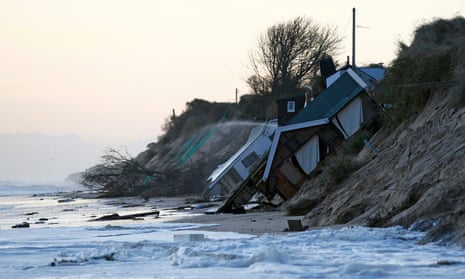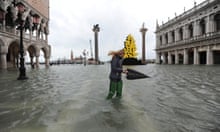Rising sea levels will claim homes, roads and fields around the coast of England, the government’s official advisers have warned, and many people are unaware of the risks they face.
The new report from the Committee on Climate Change (CCC) said existing government plans to “hold the line” in many places – building defences to keep shores in their current position – were unaffordable for a third of the country’s coast. Instead, the CCC said, discussions about the “hard choices” needed must be started with communities that will have to move inland.
“There genuinely will be homes that it will not be possible to save,” said Baroness Brown, chair of the CCC’s adaptation committee. “The current approach is not fit for purpose. This report is really a wake-up call to the fact that we can’t protect the whole English coast to today’s standard.”
She added: “We could see as much as a metre of sea level rise before the end of the century, so within the lifetime of today’s children, and that has a major impact on coastal flooding and erosion.” Prof Jim Hall, another member of the committee, said: “We are not prepared.”
The regions affected include areas with soft, eroding shores in the south and east, as well as low-lying areas in East Anglia, Lincolnshire, parts of the south-west such as the Somerset Levels, and the coast between Liverpool and Blackpool in the north-west.
The entire coast of England is already covered by shoreline management plans, developed by the Environment Agency and local councils. These would cost £18-30bn to implement, but have no funding and no legal force. The CCC analysis found that, for more than 150km of coast, the plans to hold the line would cost more than the property and land that would be protected.
For another 1,460km of coast, the benefit of holding the line was twice the cost, but the government only currently funds defences with at least a sixfold cost-benefit ratio. “Funding for these locations is unlikely and realistic plans to adapt to the inevitability of change are needed now,” said the report.
The report also found that 520,000 properties are already in areas with significant coastal flood risk. However, this may treble to 1.5m by the 2080s without action.
Currently, 8,900 properties are at risk from coastal erosion and in 2014 the Environment Agency calculated that 7,000 homes, worth more than £1bn, would fall into the sea this century. But the CCC report found that in the 2080s another 100,000 properties would be at risk of sliding into the sea.
As well as properties, key infrastructure is also at risk from the sea level rise and bigger storms being driven by climate change. In the 2080s, 1,600km of major roads, 650km of railway line and 92 stations will be at risk, the CCC found. Ports, power stations and gas terminals are also in danger. A further risk is toxic waste from old landfill sites falling into the sea as the coast is eroded; a 2016 study found 1,000 such sites at risk.
Brown said people living in coastal areas do not have access to good information about the risks they face. “A retired couple could buy, with cash, a house with a fabulous sea view without being given any information about whether it was at risk of erosion,” she said.
Making better information easily available would alarm people but was vital, said Hall. It would also affect property values, he said: “If it was better communicated, as we think it should be, then that would have a [negative] impact on house prices.”
The government must work with local councils on long-term, funded programmes that engage people and help them move if necessary, the CCC said. “Those are very difficult decisions,” said Brown. “Local councils are in a very tough situation having to raise those kind of issues with their communities. There may be a bit of denial going on in local authorities.”
A government spokeswoman said: “The environment secretary [Michael Gove] has been very clear – we will take the action required to ensure our country is resilient and prepared for the challenges the changing climate brings. The government has already committed £1.2bn of investment in coastal erosion and sea flooding projects over the next six years to better protect 170,000 homes.”
In England, only 45% of the coastline remains wild. These stretches of hard cliffs, shingle banks and mudflats can respond to rising sea levels in a natural way. But for the 55% that is developed, a choice between building further defences or allowing the sea in has to be made.
For big cities such as London, bigger defences make economic sense. “That’s going to cost money and that’s not very good news for the chancellor, but it’s just the start of the costs of climate change,” said Hall.










